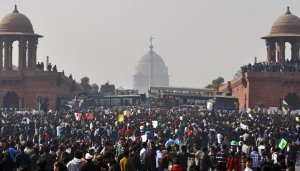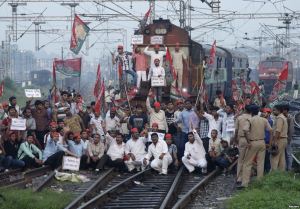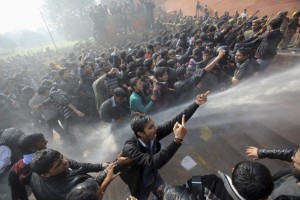A BRIEF NOTE ON POLITICAL STRUCTURE
PRASANNA K CHOUDHARY
Human communities self-organise in order to reproduce themselves, and like production relations, political structure of a given society is the product of this process of self- organisation. During different ( hunting-food gathering, agrarian and industrial ) phases of the evolution of human societies, we encounter political structures of patriarchy/
matriarchy, ancient republics, monarchy and modern democracy. We can still see these political structures co-existing, albeit in changed forms and inter-relationships. There have been some intermediate forms as well.
All those political structures have four underlying factors. First, a system to seek and acquire popular approval to rule. This pertains to the legitimacy of the political structure.
Second, a system of empowerment of clans, castes, classes, and similar sections which strengthens and broadens the scope of the political structure. Third, a system of governance that provides the very raison d’ etre of the existence of the the political structure. And lastly, a system of effective and fruitful interaction with other societies which provides identity, legitimacy and security to the given political structure on a worldwide scale. These four factors can be found in matriarchy/patriarchy, ancient republics, monarchies and modern democracies. In our contemporary parlance, I will, hereafter, call these four factors as democracy, empowerment, governance and global convergence. Since society is a developing category, in a dynamic political structure, we can at most see these four factors approximating a short of balance. All these factors are themselves processes and they are not only interdependent but they often interpenetrate as well. Overgrowth of any one factor at the cost of other ones leads to the decay of the political structure and to its final breakdown. Now we can look into these four factors seperately.
A. DEMOCRACY: This factor consists of multiple variables like universal adult franchise, fundamental rights/political freedoms, rule of law/equality before law, etc. There is an inherent mechanism in democracies of its renewal after every few years. Giving proper weightage to each of the variables on a scale of 0 to 9, we can find out the Index of
Democracy ( I D ) in a political structure.
India is a land of 2794 communities speaking 321 living languages and dialects and encompassing an extraordinary range of variations. (11) None of these communities form majority of the population – at best they come to about 10-20% of the population barring a few exceptions. Hence only a coalition of communities can rule in India. On the eve of every general election, we find a feverish attempt on the part of almost all the political parties to build a viable winning coalition. The sheer number of communities provides the possibility of an infinite series of permutations and combinations. Hence, for the political parties, it proves to be an endless act of social engineering.
Due to the above-mentioned feature of Indian society, some instability is inherent in our polity. Given the inherent instability, every ruling coalition is forced to leave open the door for new recruitments. Hence, coalitions normally attempt to rule by consensus. Social engineering to form a winning coalition of communities and ruling by consensus ( or to use the term coined by John Rawls ‘overlapping consensus’ ) constitute the core of democratic functioning in India.
B. EMPOWERMENT: Democracy itself empowers people in general. But people are organised in communities, and despite social engineering and attempts to rule by consensus, democracy remains basically a majoritarian rule. Many depressed/minority communities of various hues may feel alienated and left behind in this process.
Moreover, every society inherits stratified structures and inequalities from the past. Between two poles of atomized indiviual ( supposed to be equal ) and an abstract political structure ( supposed to be neutral ), there remain many layers of inherited and acquired identities.
These objective conditions provide ample space for agitations and rebellions on the part of aggrieved and alienated communities, even in functioning democracies. In order to be sustainable, political structure needs to incorporate empowerment of these communities (some writers call this system consociationalism ).
Raising an all-important question of ‘equality of what ?’, Amartya Sen ( like Thorstein Veblen and Vilfredo Pareto, Sen, although an economist, is mostly quoted by sociologists and political theorists ) emphasized on the recognition of the ‘plurality of spaces in which equality might be assessed’ and delineated his differences with Rawlsian focal variable (of primary goods ) and his theory of ‘justice as fairness’.
A system of positive discrimination in favour of depressed, socially backward and alienated communities constitute the core of empowerment. The concept of ‘Pareto optimality’ much used in welfare economics, and further used by Sen in terms of liberty, may apply in case of empowerment as well. Corresponding to Pareto optimality in the space of utilities, efficiency in terms of empowerment would demand that the situation is such that no community’s empowerment can be increased without cutting down the empowerment of some other community.
In our case, in a general democratic set-up, a system of reserved constituencies, panchayati raj institutions with reservations, provision for autonomy under sixth and seventh
schedules, institution of zonal and inter-state councils, reservations in jobs and educational institutions, various financial institutions and distribution systems exclusively catering to the needs of poor, depressed and backward communities, etc. provide ample cushion for withstanding the demands of empowerment. Moreover, due to new economic initiatives, new groups pressing for power-sharing. Empowerment too is an ongoing process.
Giving proper weightage to its different variables, we can deduct an Index of Empowerment (I E) in a political structure.
C. GOVERNANCE : Every political structure has a system that is exclusively meant to ensure the smooth functioning of all other systems. It is a sort of delivery vehicle (which scientists call a vector) in the body politic. Governance is precisely that system, and it too incorporates a number of variables.
Any democratic polity can hardly afford to ignore the issues that have a direct bearing upon the livelihood problems of the vast masses. Hence, macro-economic management
is one of the important tasks of governance. How is this task accomplished may be debated, but good governance involves ensuring an impressive rate of economic growth, keeping the rate of unemployment and inflation well within manageable limits, declining rate of people living below the poverty line (i.e., effectively putting in place a system of poverty-alleviation and social security), ensuring the accomplishments of national goals ( as, in our case, enshrined in the Directive Principles of our Constitution ), etc.
Second, good governance means transparent, responsive and (result-oriented) accountable administration. Third, governance obviously involves law and order management. Lack of effective governance or mis-governance leads to the overgrowth of other factors in the political structure. This overgrowth may in turn develop into malignant tumors, and to prevent the entire body politic from getting sceptic and collapsed, urgent surgery is required.
Index of Governance ( I G ) can also be calculated taking into account the variables of governance.
D. GLOBAL CONVERGENCE : The evolution of human society has been an interactive process since ancient times. However, the form and content of interactions among tribes, societies, nations vary according to the varying modes of production. In our age, in the wake of Information-Communication-Entertainment (ICE) revolution and con-committant globalization, almost all the classes and sections ( be it capitalists, peasants or workers ) are getting dislocated and striving to readjust and protect their interests.
Internet and satellite technologies have exposed every society to an unheard-of global exposure, both materially and culturally.
Every political structure since ancient times has an inherent system of interacting with the world around itself. In this process, some societies get dominated and colonized and some emerge as hegemonic powers. Yet there are ample examples of beneficial interactions beyond this hegemon-vassal framework. In this age too a dynamic political structure can venture into a beneficial global convergence through bilateral, multilateral and global mechanisms successfully enlarging its identity, legitimacy and security among the comity of nations.
There are many variables involving global convergence, and in this case too, we can arrive at an Index of Global Convergence ( IGC ) in the political structure.
Here we have briefly narrated the four factors of a political structure. Their combined operation can be termed as the quadra-force behind a dynamic polity. Taking the indexes of these four factors as variables, we can well determine the composite Index of a Dynamic Political Structure ( IDPS ). This index, in my opinion, is more important than many other indexes currently in vogue. Other indexes base on actual achievements, while this index informs us on the inherent ability of a polity to achieve. This index even helps us
to foresee possible areas of political crisis, conflict and agitations, and to identify the remedial measures. By the way, it should be made clear that of all the four variables of a dynamic polity, focal variable keeps changing depending on the changes in society (e.g. democracy became the focal variable during the emergency; in late 80s and 90s, empowerment of rural middle classes – as distinct from the metropolitan middle classes – comprising of intermediate castes became the focal variable in north India ). In the Index of Dynamic Political Structure on a scale of 0 to 9, 0 obviously means an absence of any political structure whatsoever, while 9 stands for a perfect state in all its dimensions. This state too is unattainable and has only a comparative theoretical value. There has never been a time in human history ( nor there will be any time in future ) when human communities lived in perfect peace and harmony. Such ideals at best give vent to our some inherent wish. Spiritualists would like to co-relate that wish with our inherent longing to merge with the Infinite, while the psycho-analysts will identify that wish as a sublimated manifestation of our inherent death instinct. Politics, however, belongs to the realm of erotic instinct.
Below I can now elaborate my own classification of the index-points. 8-7: Excellent; 6.9-6: Very good; 5.9-4.5: Good; 4.4-3.5: Average; 3.4-3: Bad; Below 3: Worse. Decay sets in between 3.4-3, and disintegration begins in the last category. If remedial drastic measures are not taken, all-round anarchy may result in Balkanization or colonization.
EPILOGUE
A dynamic political structure facilitates, in an increasingly better way, the self-reproduction of the given society. It is supposed to be capable of successfully meeting the challenge of grass-root level violence, of withstanding various stresses and strains of a changing society, and of forging and strengthening, amidst million mutinies, a million unities.
****
Photos: Courtesy: ibtimes.co.in; india.blogs.nytimes.com; voanews.in.com


